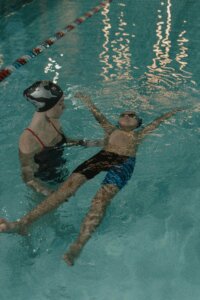Aquatic therapy is gaining attention as a powerful intervention for children experiencing neurological, emotional, and developmental challenges. This paper explores the neurobiological mechanisms that make water-based therapy effective. Focusing on sensory integration, brain plasticity, vagal nerve regulation, and motor planning, the article highlights how aquatic environments uniquely support holistic development in children with special needs.
1. Introduction

Aquatic therapy, sometimes referred to as hydrotherapy or therapeutic swimming, utilizes the physical qualities of water to enhance motor, sensory, and emotional functioning. For children diagnosed with Autism Spectrum Disorder (ASD), ADHD, cerebral palsy, or sensory processing disorders, the aquatic setting offers a calming and structured environment that fosters engagement and growth.
2. Multisensory Input in Water-Based Therapy

Water environments naturally engage multiple sensory systems at once:
-
Proprioception: The pressure from water acts uniformly on the body, improving joint awareness and reducing anxiety, especially in children who struggle with sensory processing (Baranek, 2002).
-
Vestibular Activation: Movements such as floating, spinning, or controlled submersions stimulate the inner ear, which is key to maintaining balance and body positioning (Ayres, 2005).
-
Tactile Regulation: For children sensitive to touch, water offers a less invasive way to experience tactile input, easing them into accepting physical contact over time (Kuhaneck & Watling, 2010).
3. Neuroplasticity and Learning Through Movement

Neuroplasticity refers to the brain’s ability to reorganize its structure and function based on experience. In an aquatic setting, repetitive movements and structured sensory tasks encourage new neural connections, especially in children with developmental disorders (Kolb & Gibb, 2011).
Sherrington and colleagues (2010) emphasize that enriched, task-specific environments significantly improve functional outcomes. Activities in water require both cognitive and physical coordination, contributing to long-term adaptive changes in the brain.
4. Vagus Nerve Activation and Emotional Regulation

Therapeutic immersion in warm water influences the autonomic nervous system by stimulating the vagus nerve, which governs heart rate, digestion, and emotional control.
When this nerve is activated, it increases parasympathetic tone, helping children feel calm and focused (Porges, 2011).
Hydrotherapy studies show that immersion in warm water can lead to lower cortisol levels and greater emotional balance, key factors in making therapy more effective for children dealing with stress or dysregulation (Kamioka et al., 2010).
5. Motor Planning and Functional Coordination

The resistance of water slows down movement, giving children the opportunity to focus on body control and sequencing. This is particularly helpful for children with dyspraxia or poor coordination (Getz et al., 2007).
Additionally, the buoyant quality of water reduces the impact of gravity, allowing children to perform movements they may avoid on land (Fragala-Pinkham et al., 2011).
6. Emotional Safety and Self-Confidence

Aquatic therapy is not only physically engaging but also emotionally supportive. The rhythm of sessions, familiar routines, and safe physical contact help children feel secure.
Celebrating small accomplishments in the water contributes to increased self-confidence and emotional resilience over time (Case-Smith & Arbesman, 2008).
Conclusion

Aqua therapy provides a dynamic space where sensory stimulation, emotional support, and physical challenge intersect. The neurological basis for its effectiveness lies in how water promotes calm, enhances body awareness, and supports the development of both gross motor and emotional regulation skills.
For children with special needs, water becomes a medium not just of movement, but of transformation.

Well-structured and thought-provoking article.
Thank You.
Thank you
After checking out a handful of the blog posts on your website, I really appreciate your technique of
blogging. I added it to my bookmark site list and will be checking back soon.
Your feedback encourages us to keep sharing meaningful insights. Stay connected—we’d love to hear more of your thoughts in the future!
Where to find aqua therapy in Nagpur
Placed below is link for Acqua Therapy at Nagpur
https://www.aquaphysiotherapy.com/?utm_source=google&utm_medium=wix_google_business_profile&utm_source=google&utm_medium=wix_google_business_profile
Greetings! Very helpful advice within this article! It’s the little
changes which will make the most important changes.
Thanks a lot for sharing!
Thank you so much for your kind words! We’re glad you found the article helpful. It’s great to know that the small insights made a difference for you. We appreciate your support and hope you continue enjoying our content!